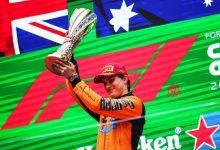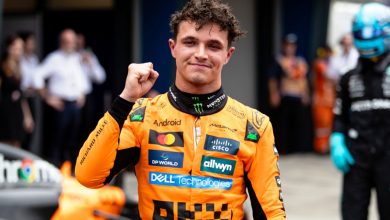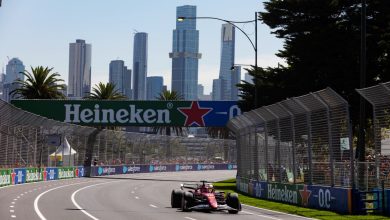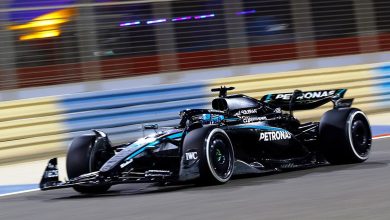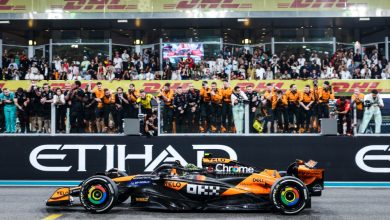Friday FIA press conference
TEAM REPRESENTATIVES – Nick CHESTER (Lotus), Jonathan NEALE (McLaren), Giampaolo DALL’ARA (Sauber), Rob SMEDLEY (Williams), Paddy LOWE (Mercedes), Paul MONAGHAN (Red Bull Racing)
PRESS CONFERENCE
Nick, can we start with you? First of all, a little insight into what happened with Romain Grosjean’s engine cover and what the explanation was?
Nick CHESTER: OK, yeah, we’ve had a little bit of an eventful day so far. On Romain’s car we just lost some fixings on the bodywork. That just pulled the top of the engine cover and broke the rest of the fixings and blew it with it.
Thank you for that. Obviously you’ve got a much faster car this but that has not, so far, translated into the points you perhaps might have expected. What’s your feeling on that?
NC: I think we’ve had a couple of races that haven’t gone our way, when we’ve looked like we’d get both drivers in the points. The good thing is that the pace of the car is there and we’re expecting that we’ll get both cars up into Q3 and start scoring points with both drivers every race.
Thank you. Moving on to you Giampaolo: obviously, faced with all the problems that you had over the winter and at the start of the year, what was the key to your relatively strong start do you think?
Giampaolo DALL’ARA: I wouldn’t pinpoint a single key. Obviously we were coming from a season where we were nowhere near where we feel we belong. We’ve been working throughout last year, throughout the winter and coming with a new car, or a new power unit, everything was working OK. On the reliability side of things, since winter testing we were pretty much sorted so it was only a matter of our performance, so that was it – a bit from the power unit, a bit from the car… let me add a bit from the tyres as well. The whole package came together. The drivers did a good job and that was it.
Clearly, as you say, you have a much more powerful power unit. What does that allow you to do from a chassis and strategy point of view?
GD: Well, not much different from anyone else can. We felt like… I mean, again going back one year we felt back then we were pretty much limited, so I would turn your question the other way around: last year whatever we were wanting to do, it didn’t change the race result. This year, basically, in one word, it allows us to compete. Basically, we are belonging to the midfield and we have competition that race by race we can challenge – sometimes this turns into points, sometimes it doesn’t, but for us it’s important to actually be there.
Thank you for that. Coming to you Paddy, the speed with which Ferrari has closed up the gap, does that reflect also that you’ve been perhaps a little bit conservative from last year to this, focusing on reliability rather than chasing performance at the start of this year?
Paddy LOWE: No, not at all. We put in a very aggressive programme over the winter, both on the engine and on aerodynamics and other parts of the car. So, no, not a bit of it. We expected a very tough season as the second iteration of this new formula and we weren’t going to get through that without a lot of development on the performance of the car. No, I think credit to Ferrari, they’ve done a good job over the winter to make a big step to approach and even exceed our performance from time to time, so that’s set the place for a very tough competition through the year.
What about your two drivers then? Nico obviously is yet to match Lewis, is that just that he’s not done a good a job or is there a technical story behind that?
PL: No, I think Lewis is performing, really, at the top of his game. I’ve worked with Lewis actually throughout his Formula One career and I would say at the moment he’s really at his peak – the best he’s been driving so far. That’s a tough prospect for any driver to compete with. Nico’s doing a great job. I was particularly pleased with how he performed in Bahrain. We let him down at the last minute, which is why he lost the second place, but you saw he did some fantastic driving, some great overtaking, which showed that he had great race craft. I think Nico is doing a good job, it’s just tough to beat Lewis. The season is still young and there’s plenty in prospect for a good battle between them.
Paul, coming to you: obviously more power unit problems today. Can you tell us about what happened with Daniel’s car in particular and was this race supposed to be the turnaround away from all of that?
Paul MONAGHAN: I think you would have to ask Renault directly what their expectations for the weekend and the future are. We had a fluid leak on Daniel’s car. We took the choice that fixing it was going to be longer than putting the next power unit in, so we said “right let’s put the next power unit in, get him out in P2, let him have a run in the car and we’ll deal with the consequences this evening”.
What about the new short nose? I understand it’s good to go. When are you hoping to use it and can you tell us a bit about the thinking on that?
PM: Well, if you look up and down the pit lane there are a number of people pursuing that topic; we’re not alone. We’re going to put as much chassis performance on as we possible can. That’s one of the aspects we’ve looked at. Best you look long and hard at the footage and see if you can find it.
Right-oh. Thank you for that. Jonathan, what appears to be a very good step today, with Jenson up solidly in the top 10. Where is that step coming from and does it get harder to make the big steps the further you go on?
Jonathan NEALE: Well, it certainly never gets easier! I think we’ve had a reasonable day today. I wouldn’t read too much into a Friday. We all like to convince ourselves that if you’re quick on a Friday you’ll be quick through the weekend but Friday’s are notoriously fickle. We don’t know what everybody else is doing, so we’ll see tomorrow just where we’ve got to. But the reality is we’ve been pushing on all areas of the car. We have aerodynamic upgrades here this weekend, we have some engine, reliability upgrades, there’s a huge amount of work still to do on our systems package – much of our performance we’re getting from systems integration work. And importantly Exxon Mobil have delivered us a fuel upgrade here as well, so in all areas, pretty much, as Paddy suggested.
There’s been a lot of change in the McLaren technical department – new faces arriving, returning faces like Peter Prodromou. How much change has been effected in the engineering ideology, the ‘McLaren Way’ if you like? Is that changing fundamentally?
JN: Yeah, I think it is. I think there are some things about McLaren that have stood the test of time over 50 years and there are other things about it that need constantly reinventing. No business stands still, no market stands still. The sport’s constantly changing and what it takes to stay at the top requires constantly to reassess everything that’s going on. I think the changes that we made during the course of the last 18 months have had a very positive impact, I think it’s ventilated the organisation a bit. I think there’s a bit more work to do and Eric [Boullier] and I are hell-bent on making sure that’s the case.
Thank you for that. Coming to you Rob, obviously from last year to this, certainly so far, the hoped for improvement hasn’t come through yet relative it the pacesetters. Why is that?
Rob SMEDLEY: Well I think you’ve got to be fairly pragmatic about it first of all and understand where we’re at and what we’re trying to achieve as a team. I think it would be fairly remiss of me to sit here and say that we are going to start competing with Mercedes but I think that if you look at our gap to Mercedes, MGP, last year and this year then it hasn’t really shifted a great deal. It was about 1% in lap time and it’s about 1% this year. It’s not where we want to be. We all know that, we all buy into that. It’s not where we want to be. We’re working on that. But the team, the business as a whole really, is on a journey and we’ve got to keep improving. We’ve got to keep developing the car, we’ve got to keep developing the business, the company. Ensuring that we’re developing in all areas. We’re not as strong as the front-running teams in lots of areas; every single area of the business. We’ve got to keep on looking inwards and go quietly about it.
So you’re the third-fastest car, basically. Mercedes and Ferrari are well ahead and the others, at the moment, seem to a way behind, so essentially your two drivers are kind of racing each other each weekend. How does that affect, internally, the strategy planning knowing that your two guys are going up against each other?
RS: It doesn’t affect anything a great deal, to be honest. The number one objective for the team is that the maximum number of points available and the finishing order of the drivers is of much less consequence. The drivers know that; they buy into that. So it doesn’t really affect us a great deal. We’re looking forward all the time and seeing if we can get in there at some point with the Ferraris but we’re looking behind as well. You’ve got Red Bull, who’ve got a huge resource and a great team behind them, lots of world championships. They’re going to come back at some point. We shouldn’t just be looking forward, you’ve got to be looking backwards as well, but at the moment, while we can, we just have to keep getting the maximum number of points.
QUESTIONS FROM THE FLOOR
Q: (Dan Knutson – Auto Action and Speedsport) Gentlemen, the rules can change in 2017. Name a couple of things that would be at top of your wish list, even if it’s not practical, that you would like to see coming?
JN: It’s very tempting to be unguarded at the moment! I think that the sport needs to rethink a number of areas. Personally, I think it would be foolish to mess around with the immense amount of good work that has been done on the power units. Maybe some minor adjustments but it’s a much more efficient package, it’s got some great technology, it’s still maturing in the sport and the price can come down if it’s left to mature because just we’re not putting in the same R&D costs. So I would leave that alone. But I would look for… we’ve spoken about that a step-change in aerodynamics, to make sure that these cars are difficult to drive and maintain that perform gap to the other junior series and Formula One remains and out and out race. We can still have the efficiency, we can still have many other attributes of the sport but I think it should just be a flat-out race.
Nick, what would you do?
NC: I come from a slightly different viewpoint I think. There’s a lot talked at the moment about the rule changes for 2017 but I think people forget at the moment the racing’s actually quite good. There are some very good battles up and down the whole grid and as the cars’ performance is improving a lot – I think we’re seeing two seconds improvement from last year – do we really need a huge change of regulation? A huge of regulation is going to open up the grid again, there’ll be bigger differences between teams and obviously it’s going to add a lot of cost, so I think we shouldn’t forget that show’s actually not bad at the moment.
Giampaolo?
GD: I’m pretty much on the same line as Nick I think. I wouldn’t add much to what he has been saying.
Paul?
PM: As a personal view I’d seek to improve the performance of the cars. The mechanism by which we do it really will come down from Strategy Group to people such as ourselves and then we’ll sort it out from there. That’s what I would wish for at the moment.
Are you talking about a lot more power, that kind of thing? Over a thousand horsepower has been discussed.
PM: I’d leave the power unit aside for the moment. I’d like to do it more on the chassis side I think.
Paddy?
PL: I agree with Jonathan that above all we must maintain Formula One cars as the pinnacle of motorsport. That’s the presentation that Formula One is and that’s what maintains the show and the attractiveness to a global audience. Even amongst topics such as cost saving, which often comes up, above all we’ve got to maintain that show and that means the cars must be truly spectacular. But in terms of rule changes, I think it’s not absolutely clear that we need to change the cars radically, that’s something being discussed. As Nick correctly says, performance will increase anyway through normal development and we may arrive at the position we want to be through natural development. I think an interesting area is just in the sporting regulations. There are a lot of thing we can do that would improve the show without spending a huge amount of money changing the cars themselves. Changes to sporting regulations generally don’t attach a lot of cost and can change the sport in subtle ways that improve the spectacle, improve the interest, improve the uncertainty, which is what you really want from race to race – that it’s not absolutely clear who is going to win.
Can you give us an example of what you’re thinking?
PL: I think we’ve been discussing ideas like the use of tyres, how tyres are allocated – but I think we’re actually on the lookout for people to come up with interesting ideas. But I still say in that context, again agreeing with Nick, the sport, in my view, isn’t in a bad shape. And I don’t think we need to run around thinking we need to do drastic things.
Rob?
RS: I agree entirely. I think we should leave it alone. In the main we should perhaps think about stopping tampering with it rather than thinking we’re going to create a new set of rules and that’s going to fix everything. Every time you create a new set of rules, you’ll usually find the people with the biggest resource or with the cleverest thinking, or the people who stopped working on the current generation of Formula One cars, come out with quite a big gap. That’s what, when we talk about these boring races, that’s what we’re referring to isn’t it? A team dominating at the front – but a team dominates when we have radical rule changes. I think that we do have to seriously think about not changing anything. Nick was quite right in what he said: the racing is very good. Out front this year you’ve got Ferrari and Mercedes and that’s making for some good races. Behind us it’s everybody in, isn’t it? There’s some good racing going on there. I also agree with Paddy’s sentiment, that there’s lots of things we can do with the Sporting Regs, which aren’t going to cost a great deal of money. We have to be responsible in how we spend. I’ve said this before. The average man on the street, the people who we’re trying to drag into the circuits, or who we’re trying to drag into viewing us on a Sunday afternoon, they don’t care about spend: they just want to see racing. Even the technology, to a certain extent, is of less interest. So it’s got to be the racing spectacle that we put at the forefront. By having a radical rule change you’re not guaranteed to increase the racing spectacle – but what you are guaranteed to do is increase costs.
Q: (Haoran Zhou – LETV) I’m glad Jonathan mentioned keeping Formula One away from other junior series because I’d like to draw your attention to a ten-lap run that Pierre Gasly did in this morning’s GP2 session. He started off with some 35.4s and gradually started doing 34.5s and finished with a 33.9s. Which is around 2.5s away from Mercedes but on a par with a lot of cars here, a lot of your cars. What’s the correct way of interpreting this? Is Formula One being too slow or is GP2 being too fast?
JN: I think the racing is good – but if it’s going to be the pinnacle of motorsport then it has to be. The engine technology has been fantastic but we flip-flop between whether we perceive aerodynamics as some evil that entered Formula One at some point. The fact is aerodynamics are around us all the time: the genie is out of the bottle, let’s embrace it and go with it. The cornering speeds, I think, you could do something about and I think that would stretch some of the drivers a bit better. Got to be careful about safety because the circuits aren’t changing very much – but we have gradually pared back various parts of the aerodynamic aspects of this, for a variety of reasons. I think there is room for a little bit of tweak on that without upsetting the show. It is true, performance will continue to develop but I just think I’d give it that nudge and I think it’s the cornering speeds, if you look at things like Super GT, which you’ll be familiar with, or GP2. It’s those areas that we just need to watch.
I wonder Paddy, if we need an explanation of this phenomenon, why it is that this has happened here?
PL: I’m not a great expert about GP2 but it may be that they’ve improved a bit. Formula One is in an early phase of a major regulation era. This is the second year of a set of regulations, so generally performance will increase until the next reset is required. Those resets are normally introduced to control safety through cornering speed. So I think we’ve got a period now where we will stretch out relative to some of those other formulae. For 2017 it may be that we need to give it a bit of a nudge and that’s what’s being talked about. Perhaps some more aerodynamic performance could be added – but historically we have always reduced aerodynamic performance step-by-step. I can’t recall us ever increasing it in all the years.
Giampaolo, do you have a view on this?
GD: Maybe in addition to what was correctly mentioned, this gap will open but also on the other side it would be wrong if the gap would open beyond a certain extent if we want to keep considering GP2 as the last step for a young driver to be formed into Formula One. In latest times the young drivers unfortunately get less and less chances to be actually forming themselves within a Formula One team – at least into the car. Having this final series before Formula One, let’s say the closest series to Formula One, not too far away I think is something that could be beneficial on this side of things.
Rob, what would be the ideal gap, do you think, from Formula One to a series like GP2 in a perfect world?
RS: I don’t know, you’re asking the wrong person. It’s got to be at least 6-8 per cent, hasn’t it? I think the question, what we’ve perhaps missed in the question that was asked was if you look at the starting times of the run that you referred to, compared to what we were doing this afternoon on a hot track, then you’re probably looking at around six per cent. The difference is that, at the end of the run – and I haven’t looked in any detail – but at the end of the run the times were a lot quicker. I don’t know who the driver was or the car was that you are referring to but the times were a lot quicker than what he started off with. That’s perhaps a trend that we’ve seen here in GP2 that we certainly haven’t seen in Formula One. We all agreed through various means that we wanted a greater spectacle in Formula One – and one of the means of achieving that was to have higher tyre degradation and that’s what we’ve got. We do have high tyre degradation now, compared to the past, in Formula One. So at the end of the runs, yeah, if you take the fuel-corrected times out of it, we can be upwards of two seconds slower than at the start of the run – certainly on new tyres. I think some of that is probably what you’ve inadvertently mentioned there.
Anything to add Nick?
NC: I think the other thing to bear in mind is that the GP2 car is probably fuelled for a shorter race – so it’s probably got a bit less fuel to carry. Also, when you look at the development of the cars, that two-three seconds gap we see at the moment will probably be six seconds by 2017.
Paul?
PM: I refer you to my earlier answer. I think we need to add some performance to the Formula One cars.
Q: (Andrew Benson – BBC Sport) We’re all taking about making the cars go faster, changing the aerodynamics, playing with the engines, whatever – but no-one seems to be talking about the tyres when we all know the drivers are driving within themselves for the entire race distance, pretty much. Why not?
Rob did address the whole question of degradation but has anyone got anything to add on the subject of the tyres? Paddy?
PL: That subject comes up repeatedly. I think it’s always been a factor in Formula One racing that you have to consider getting the most out of the tyre over a long distance. I don’t think there have been many tyres over the years that one could sprint with on every single lap. I think with the current tyres we have an interesting situation which I think has improved the spectacle a great deal, where the nature of the tyre degradation is such that cars are obliged to stop at certain points, and it produces a lot more variety. I think we’ve seen far more exciting races as a result since Pirelli came into Formula One. So, there is the aspect around drivers having to manage and not necessarily drive as fast as we would like – but I think that’s been an element in the past. It may be a slightly bigger element at the moment – but it also adds to the skill necessary from the driver. So, it’s still all part of an exciting package. And in qualifying, of course, they are going absolutely flat out.
Q: (Sebastian Scott – racedepartment.com) This is a question really for the three people from the works teams. If you look at the World Endurance Championship now Porsche, Audi and Toyota seem to be fairly reliable for an endurance race and they seem to have a great power output. Is there anything you could learn from what they are doing and apply it to the current set of regulations? As you were saying, not to make a massive change to make a quick fix or just a little fix.
PM: Yes, there is always things we could learn and yes we ought to be open-minded and yes we ought to look. There is a Power Unit Group that, if it wished to adopt something like that, can make its statement and put its foot forward. I wouldn’t suggest that we go down the route of a quick fix. I don’t believe with our sport there’s anything such as a ‘just’ job: you can’t ‘just’ do that. There’s no such thing as a quick fix, it’ll normally come back to bite. We’ve got adequate time now to make some sensible steps, enhance our sport and keep it as the pinnacle and we don’t necessarily have to have wholesale change but why not look, why not learn and then put our step forward and keep us where we are.
Paddy?
PL: I’m not a great expert, I’m afraid to comment. I would just say that the power units we have are extremely sophisticated. They incorporate hybrid systems which are very road car relevant and I think that’s been a great direction for Formula One. I don’t see a great need to change the engine formula now because we’ve only really just adopted it.
Jonathan?
JN: I agree with Paddy. If we look at what’s going on inside Honda at the moment, then the technology is exciting and relevant, we’re at the foothills of the climb that we have ahead – but as Mercedes have adequately demonstrated over the last few years, that power unit has matured. It’s a really good piece of technology and it’s reliable. There’s something we can all learn from that. I think we just need to keep pushing away at the series that we have and it will come to us.
PL: I think it’s worth mentioning, because I forgot to mention it, that talking about the World Endurance Championship… these engines now are doing a huge mileage compared to history, four, five, six thousand kilometres compared to barely three hundred kilometres in the old days so they are already endurance engines and I think that’s a point to note and a point which we should appreciate and celebrate actually.
Q: (Mike Doodson – GP Week) Next week there’s going to be a meeting with the strategy group when I think you’re going to decide on whether or not to have a fifth power unit. I realise that given the alarm and disparity and reliability between certain power units which we won’t mention there is a danger that the World Championship for Drivers is going to be compromised in some way. Bearing that in mind, what do you think the chances are of there being a fifth engine permitted or agreed by the strategy group?
NC: I’ve got to say that I can’t really answer for what the strategy group will decide. I think we’ve got a regulation at the moment which is four power units. I think it will need o be unanimous if it goes to five.
JN: I don’t know whether it will pass. There are some conflicting views. There was a certain degree of unanimous agreement amidst the teams in Malaysia. I think that position has changed a bit from what I can pick up in paddock rumour at the moment, but what matters most is what case is put to the strategy group next week. I think that if it isn’t simple, if it becomes… if it goes to five engines with a thousand strings attached and complex other paraphernalia around it, I don’t think it will go. I think it would be advantageous… we would obviously benefit from it because we’re in a situation where, as a new entrant to the sport with Honda, we would very much like that additional fifth engine – we would, wouldn’t we? – and we think that would be fair for us. I’m pretty sure Renault would feel the same way. They’re investing in the sport, they’re a big organisation, it’s important for their brand as well that they have some degree of glide-path on this but it’s a fair race for everybody and I accept that . If it’s four it’s four, if it’s five it’s five.
GD: For me the regulations are in place. There are deadlines to change them. Those deadlines passed so I think for this year it should stay as it is.
PM: Personally, I would support the fifth engine. The strategy group is the first step of three to a rule change. If it proceeds, all well and good. If it doesn’t you play the hand you’re dealt.
PL: I think the original reason that people talked about a fifth engine was because in this year where we first reduced it to four per year, there was very little running on Fridays and it was seen that this was the explanation so the original reason it was agreed that we would look at introducing a fifth engine to improve the amount of running that was done on a Friday. We would agree with it in that context. We will see what happens in the strategy group.
RS: Yeah, we’ll go before the strategy group who will need unanimous agreement. It’s, at the moment, of less consequence to us. We’ve used one engine and another group of engineers were working towards four engines. We’ll see what’s decided at the strategy group. I think one point that I would pick up on that you made is that the Drivers’ World Championship, the Constructors’ World Championship could be compromised. Yeah, it could, that’s what the rule book is for.
Q: (Dieter Rencken – Racing Lines) Question to Jonathan please: Jonathan you alluded earlier on to the staff change, manning changes, restructured McLaren. When it was all announced 18 months ago, you were acting CEO if I remember. Are you still acting or are you doing it and have there been any other changes within other companies, for example McLaren Advanced Technologies, which have a bearing on Formula One?
JN: There’s a couple of question in there, Dieter. Let me just handle the first one which is yes, of the job titles that I had, it still includes one that’s called acting chief executive officer. I am still there, I am not hung up on a job title. Eric and I are running the team, we like the way it’s going at the moment. Ron doesn’t appear to be ready to make any imminent changes there which is OK at the moment, so I assume he’s comfortable with it. But let me just be clear about your supplementary question there which is about the changes elsewhere in the organisation. There are lots of things going on at McLaren Automotive and McLaren Applied Technologies but they are completely ring-fenced away from us so there’s zero distraction away from the work that Eric and I are doing, which is purely focused on the relationship with Honda and our on-track performance. That is our first and only priority.
Q: (Craig Scarborough – Scarbs F1) General question to everyone: we’ve been speaking about wanting to improve lap times. We always want to talk about cutting costs. I imagine that a lot of your R&D budgets actually spend on actually trying to circumvent previous cost-cutting attempts. We don’t want to play with engines, we don’t want to play about too much with downforce. Is there a potential that we could lose some innovative technology in 2017 or in the future? Maybe things like active aero or active suspension to improve corner speed, straightline efficiency in order to get the lap time but without having to spend too much money?
NC: Well, it’s a point. Obviously that would be quite a big change. There would be a lot of investment required to generate those active systems. For me that goes back a little bit to earlier subject which we were on: we don’t want to change it too much because I think we’ll spoil the show.
JN: Well, I’m quite attracted by the new technology and what else could we do, providing it’s relevant to the markets that we serve and the sponsors who back us in some way. Now that might be for the fans to make it more interesting or it might be because it’s more relevant to the people who bankroll the teams and the whole show here. Providing it’s relevant and not technology for technology’s sake, then I think there are opportunities to do things on the chassis, as we’ve done on the engine.
GD: Although it’s not my field in my team, I know that we are on the side of cutting the costs which is fundamental for the survival of the small teams. Having said that, for sure there are different ways of evolving Formula One or improving performance, but most of the time, for as much as you can think about going back, it results into further reserves and further development and ultimately additional costs. It’s a really complex topic to sort.
RS: I think that you have to bear in mind always that F1 has to be the pinnacle of motor sport. It has to be about innovation as well. It’s always been engineering-led, it’s always been technology-led and it has to be about engineering, excellence and innovative excellence, and I think that as long as… I would agree with Jonathan, as long as that’s relevant to the sport in general, to the business, to the markets we serve, then yes, why not look at things. There’s got to be a cost-effectiveness as well. It’s got to serve the business and the sport in general. It hasn’t just got to be ‘we’re producing something and we talk about it all winter and it’s going to change the world and then it changes nothing.’ We’ve had a few of them before. Yeah, we should always be looking at innovation, that’s what keeps us going, I think, especially the people that you’ve got here in front of you. That’s what we all do it for.
PL: Yeah, I agree with Rob and Jonathan. I think that where it relates to costs, often it’s not more expensive and a suspension is an interesting example that has been studied over the last few years. Sometimes we spend more money designing systems that get around the constraints of the regulations in an indirect manner, so some of the suspension systems we have at the moment are incredibly complex and therefore expensive and maybe cheaper if they were implemented using electronics.
PM: I think it’s prudent to keep an open mind and keep a review on all aspects of what we do and as you say, whilst people have said try and keep our sport as the pinnacle. Personally, I wouldn’t agree with going down the active suspension route as it will drive the cars and development direction which I don’t think is healthy for the sport. Active aero? If there’s an interest in it and we can come up with systems, kind of supplementing DRS if you like, which can be used to create a performance differentiation and performance equalisation. Whatever we aim to do with it, it’s interesting to do. As I said, it doesn’t come for free. I think we’ve got to decide what we want to do for 2017. If we’re to pursue such avenues, we can look and take it from there.
Q: (Christopher Joseph – Chicane) A question to both Rob and Jonathan: you talked about how vital it is that the technology is relevant, not only to the businesses, the suppliers and yourselves as engineers. Do you think enough is done to promote the technology side of the sport and if not, do you think we could do more in terms of more media times with people like yourselves and your colleagues and relating that technology to the fans?
RS: Yes, I do. I think it’s imperative that we try to do more. I think it’s imperative that Formula One embraces all different types of media and tries to get the technology across to people. I think it’s a little bit lost. We’ve got incredibly complex – almost quite beautiful in their complexity really – the power units and the cars that we have now in this current guise of Formula One and it’s lost. We’re not doing a good enough job of getting it out to the people. We’re not doing a good enough of getting it out so that… they’re difficult enough for the likes of the people sat here to understand. If you try and convey that in our language to the people who watch it at the moment, the general public who just want to see Formula One racing, then if you look at what’s happening now, then it’s not happening, it’s not good enough and we do have a responsibility. I think it’s part of the sport, it’s an incredibly important part of the sport and we need to probably do a better job of conveying it to the general public in simple terms what we do and how we go about it.
JN: Yes, it’s a good question. I think that we’ve spoken a lot about the product, the car but the product is the end of a process and there is as much technology, innovation and excitement that sits behind every team represented here on this stage. We’re really lucky to work in Formula One, we should never lose sight of that. We do some amazing things in these businesses and maybe we don’t do a tidy enough job through an event weekend like this, but anybody… the guys will attest here, anybody who comes into our businesses and gets up close and looks at what it takes to put two cars on the grid twenty times a year, it is extraordinary, but from the manufacturing technology through rapid prototyping work, the simulation, computational fluid dynamics, it’s a really rich mix which is why it offers such interesting jobs for young engineers and scientists. Each of the teams is certainly working very hard, most of these guys are sitting with businesses that run effective web sites and media channels, the digital environment is constantly changing, for us it’s very hard to know how to get traction when they’re just spamming out content left, right and centre. And I think certainly if we’re going to address the demographics of the audience, then it’s how we access those people like my children and what will be their children who don’t do terrestrial television any more – that’s gone – and how we tap into some of that and I certainly we could be more effective in that. But that’s easy to say, but actually doing something practical and making it happen is quite difficult because it’s so fragmented.
PL: I wasn’t asked that directly but if I could add to that question, slightly correct Rob because I think Mercedes spent a great deal of effort actually publicising… making the most of the hybrid power that we produce. That’s been used in a lot of advertising over the last 12 months, making a big story around that. Hybrid is a name that I think now, through Formula One, it’s being more associated with a cool car rather than an uncool car and I think there is a lot going on. Of course we could do more but it is beginning.

